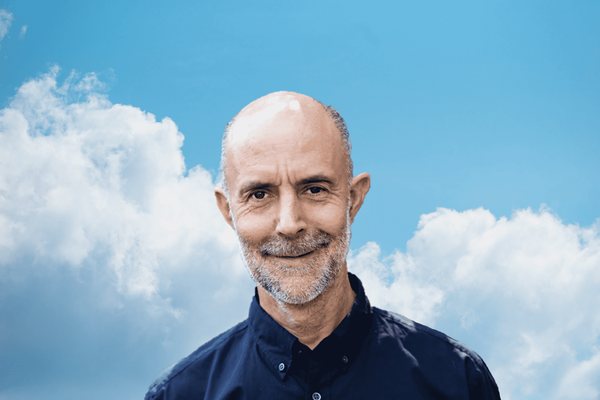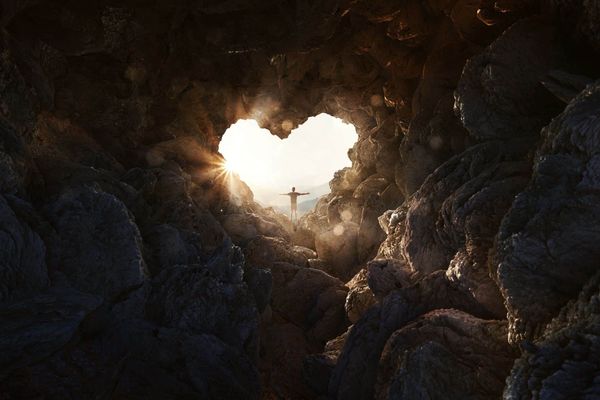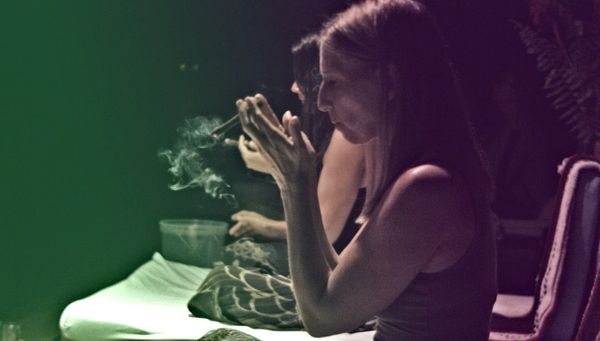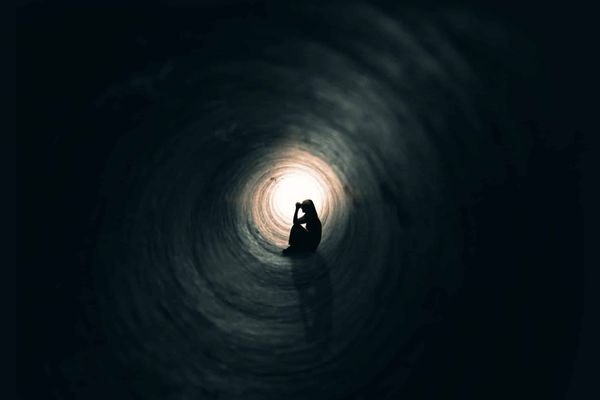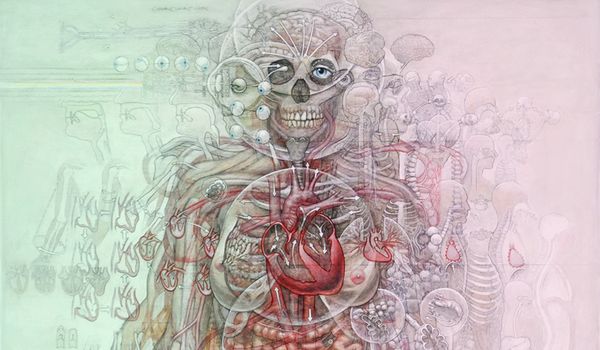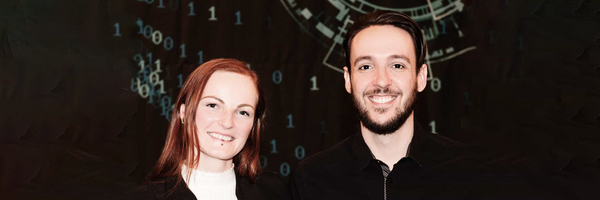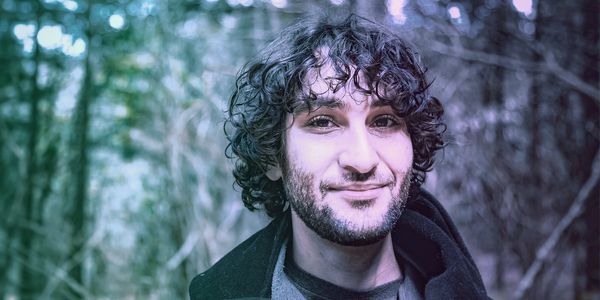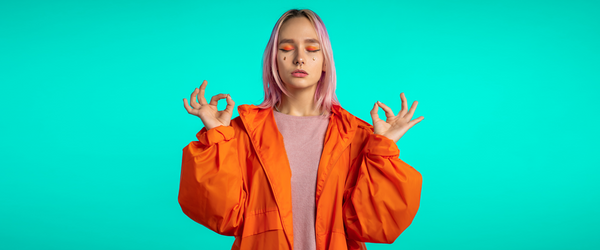Nikojive • • 27 min read
Entering the Caves of the Unconscious: A Story of Crossing the Threshold on the Hero’s Journey
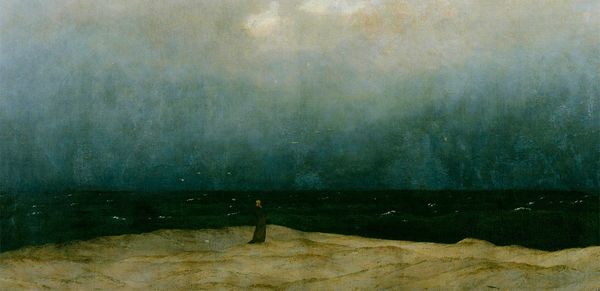
This is post 3 of 3 in the series “Hero's Journey”
Nikolaj Knub’s journey on the Hero’s Path.
- How I Embarked On A Slippery Hero’s Journey By Following My Bliss(ters)
- Finding Guidance on the Hero’s Journey: A Story of My Apprenticeship With “The Cacao Shaman”
- Entering the Caves of the Unconscious: A Story of Crossing the Threshold on the Hero’s Journey
The painting above is by David Caspar Friedrich. In it we see a monk looking out across a vast and voluptuous sea. It is getting dark. The wind is strong, and the sea seems fierce and cold. That is what we can see and behold. But what do you think goes on inside our monk, as he looks out at the sea? What are his thoughts and feelings?
Personally, I imagine that a part of him wants to stay safe; wants to stay on shore where the footing is secure and the foundation strong. He is fond of his warm monk’s robe and glad to go back within the reliable walls of his monastery – maybe to enjoy some hot soup, go to mass, and sing psalms with his brothers.
Yet I suspect another – and perhaps stronger – part of him; a part which is drawn by the sea and completely seduced by the mystery of the unknown. There might be fear and trembling in our monk, but there is also longing. For he knows that it is the stormy sea – not his silent cell – that harbors his true salvation, and he yearns for its dark, infinite embrace.
Thus transfixed he stands at “the threshold,” about to undertake what C.G Jung once called “the night sea journey.”
As the Journey Unfolds, We Come to An Edge
Already we have come a long way on the trail, and one archetypical step at a time our mythic “journey of the hero” is unfolding itself. In the first part of this series of essays, I described how I embarked on my “hero’s journey” by answering “the call to adventure”; a call that brought me to the magical Lago Atitlán in the volcanic highlands of Guatemala. Here I apprenticed with Keith, the so called “cacao-shaman of San Marcos.” In the second piece of this installment I shared my experiences with Keith and the cacao, while exploring how “finding guidance” can be tricky, yet necessary step on our journey.
Now, in this third part, we come to an edge on our hero’s journey, and – just like our monk – we are confronted with a vast and voluptuous sea. “Crossing the threshold” is at hand, and a perilous journey into the night awaits us.
In this third piece of my hero’s journey I share the story of how I ended up spending 5 days in a jungle cave – immersed in complete darkness. Certainly, it is one of the craziest things I have ever done, but looking back I can say – without a doubt – that it was also one of the most rewarding experiences of my life; one which I am still trying to digest, and probably will be for many years to come.
For several reasons it is not an easy task for me to describe my experience. For one, my story is a highly symbolical one and doesn’t lend itself easily to a cool interpretation by my rational faculty. In fact, it looks rather silly in the eyes of reason. If I am to touch the heart of it, then I will have to unfold my experience as a symbolic ”event,” made from the stuff of dreams and images – not facts and formulas. This is why I began with our monk, for this piece might be more akin to a painting than a paper.
Mapping my own experiences within the mythological framework of “the hero’s journey”, I will explain how the cave came to represent a threshold on my journey. I will describe what it means to “cross the threshold” and unravel the psychological function of its protectors – the so-called “threshold guardians”. Nonetheless, it will not suffice to interpret a chain of outer events. If I am to explain why I ended up in the dark cave, I will have to dig deeper and decipher the inner forces that were at work in my being.
As I explore the strange drive that probed me to enter the dark, I shed light on the Jungian notions of “the collective unconscious,” “archetypes,” and “individuation.” Archaic and primitive, yet effective and powerful, I wonder if I was in the grip of an archetype when I decided to enter the cave: an ancient motif of death and rebirth.
Perhaps “the hero’s journey” is more than just an interesting theoretical framework. Perhaps it is an animated map, that lives and breathes in the depths of all of us, collectively?
Meeting the Nymph
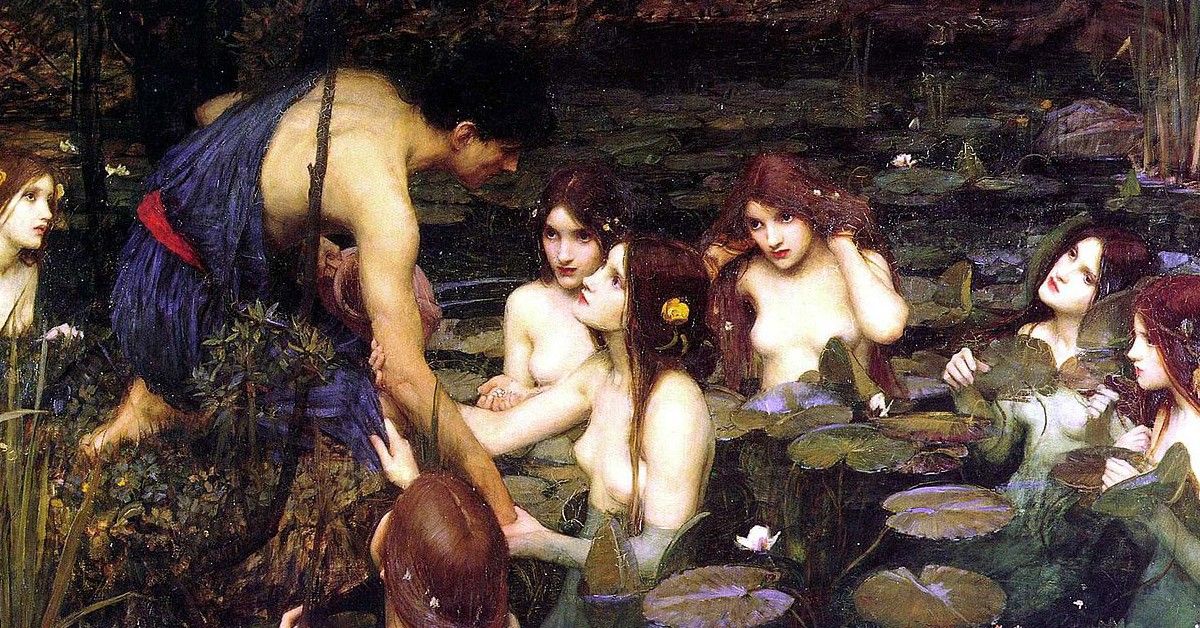
(Hylas being abducted by the nymphs. Painting by John William Waterhouse, 1896)
Let me begin by telling you how I found my way to the cave. Like Hylas in the painting I was happily abducted by a beautiful young woman: Sarah, the nymph of my adventure.
As I met Sarah she was soaking up the sunset at the banks of the beautiful Lago Atitlán. Some months prior she had encountered ayahuasca and fallen deeply in love. Now she was heading down into the tropical lowlands of Guatemala in order to continue her conversation with the divine vine. She had found an internship with an Italian woman by the name of Elisa; a modern “curandera,” working with plant medicine in the jungle.
Enchanted by the rising moon at the lake and Serah’s musing, I felt an immediate pull to follow her down into the jungle. I went straight home to my hostel and found Elisa’s place on helpx.com. “Alquimia – Centre for Healing Arts” was offering an internship in “Mayan Ethnobotany,” including a special course on “Shamanism and Master Plants, and there was mention of a special “darkness retreat” in a cave. Intrigued and excited, I was certain had found my next destination. The nymph had me in her sway, and I was joyfully dancing along her tune; letting myself be led into the forest.
Being seduced by a nymph can, however, be a dangerous affair. Whether it is a nymph, a muse, a siren, or a mermaid, these mythological figures represent what Jung called “the anima”: the feminine aspect of a man’s psyche. When we project this part of ourselves onto an external female, they can hold a tremendous power over us – and not always for the better.
We can become so infatuated, that we will readily do anything for our idealized Other – even if it means compromising our own health and well–being. A woman can then turn into a “femme fatale” – a temptress leading us into despair, destruction, and in worst case, our grave! This is what is captured in the mythological motif of Hylas’ abduction, or of sailors who shipwreck because they are lured too close to shore by the enchanting music and sweet voices of the sirens.
Surely, such enthralling figures can be disastrous to deal with – but only if we are not connected with our own femininity. If we dare to own our emotional life – instead of projecting it away – then “the anima” can establish itself in its original positive function as “the woman within”: a guide to our inner life conveying the vital message of our unconscious. We will then be less susceptible to the hazards of a “femme fatale,” as we become less dependent on having our emotional needs met from the outside.
To my luck Sarah’s role in my adventure was not one of subtle seduction, but rather of gentle guidance. She might have led me into a dark cave, but I feel that she was only shedding light on a process that was already well under way inside of me. Our meeting at dusk marked the beginning of a night that I had long awaited. I was ready to approach the more muddy, murky, and mysterious rainforests of Guatemala.
My first time in the jungle is still blurry to me: A sort of feverish dream full of shakes and shivers, weird hallucinogenic dreams, and curious herbal cocktails to cure an illness which kept me in bed for most of a week. To put it gently: I had to acclimatize. At Lago Atitlán everything had been so clear and crisp. Here in the jungle it was hot and humid, and the mold was creeping in everywhere – even into my mind it seemed. Being surrounded by dense and deteriorating rainforest I could almost feel the decay with my senses. Everything had death written all over it.
Yet, at the same time it was so full of life: The air was replete with oxygen; everywhere I looked there was vegetation and constantly there would be a creature on the move in my vicinity – ants and insects, lizards and spiders, birds and fish. Death and life were feeding each other in abound in this rich, beautiful corner of the Mesoamerican rainforest.
As soon I emerged from my feverish haze, I began to explore more of my new beautiful surroundings, including “the cave.”
Encountering the Cave
I’m not sure how I had imagined it to be, but when I saw the cave for the first time, I was afraid… I was petrified. There were ants crawling all over the place; the ground was muddy, and the air was damp and humid. It was a constrictive, narrow, and low sort of passage: A canal which led down to a small round opening in the back – a sort “inner chamber” or “womb.” Even though the place was not exactly inviting, it did feel safe and protective to sit there in the back chamber.
On our way out though, we soon discovered that we were not the only ones occupying the cave. First we encountered a spider, and then a lizard suddenly popped out of one of the cracks in the rock wall. The local trabajador, Cornelio, stopped and gestured to us that we should remain standing, and with my limited Spanish abilities I picked up that the lizard was lethal. One bite could put you to the grave if you didn’t go to a hospital within a couple hours. Frozen, I looked the lizard in the eyes, as fear began to pervade my body. As quickly as possible – but trying to keep the panic on a low – we got out of the cave.
Cornelio stayed in there with his machete, and soon after a dead lizard was thrown on the ground before us. It was not the ordinary gecko, but a full-size reptile which looked somewhat archaic with its triangular face and pointy teeth.
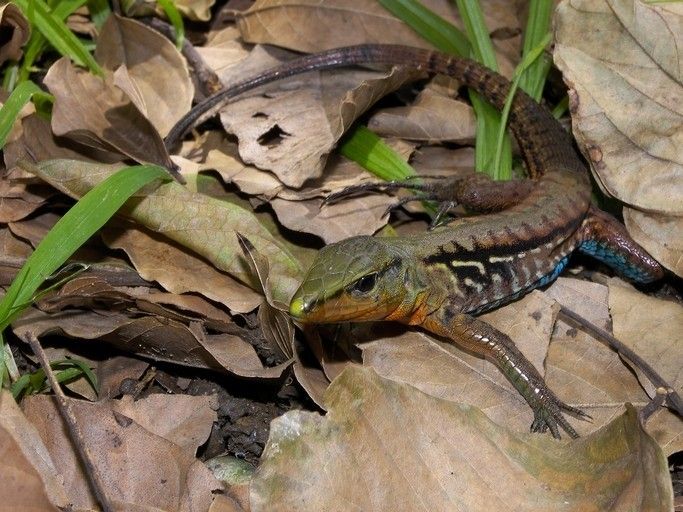
(Guatemalan lizard, Ameira Festiva)
Shortly after the dead lizard, a big toad followed suit. Cornelio was having a massacre in there with his machete, and outside we were looking at each other in shock. ‘No fucking way I’m going in there again,’ was my first thought, ‘…and to do a “retreat” in there. That’s just mad!’
I soon learned that there were no lethal lizards in the area, and the one that we had seen was quite harmless. Elisa was well-informed and apparently Cornelio and the locals had an unfortunate tendency to slay when in doubt. Nonetheless, the encounter with the lizard left a strong impression on me. It assured me that the cave was not just a sterile rock hole, but a real and living part of the awe inspiring Mother Jungle – not only loving and caring in her nature, but also lethal and consuming. To approach her womb with purely romantic assumptions was naive and foolish. And so I was warned by the lizard. It functioned as a “threshold guardian,” protecting the cave.
The Threshold Guardians
If you have ever been to temples and sacred places in Asia you have probably come across statues and images of fierce and frightening creatures, standing in front of temples and other holy grounds. They are there in order to guard and protect the sacred zone. Whether they are lions, dragons, demons, sphinxes, giants, or wrathful warriors, they all seem to warn us not to enter the holy ground in a frivolous manner. They look at us with their powerful gazes, asking: ‘Are you sure you are up for this?’ ‘Do you really want to cross this threshold?’ ‘Can you handle the powers contained within the sacred zone?’
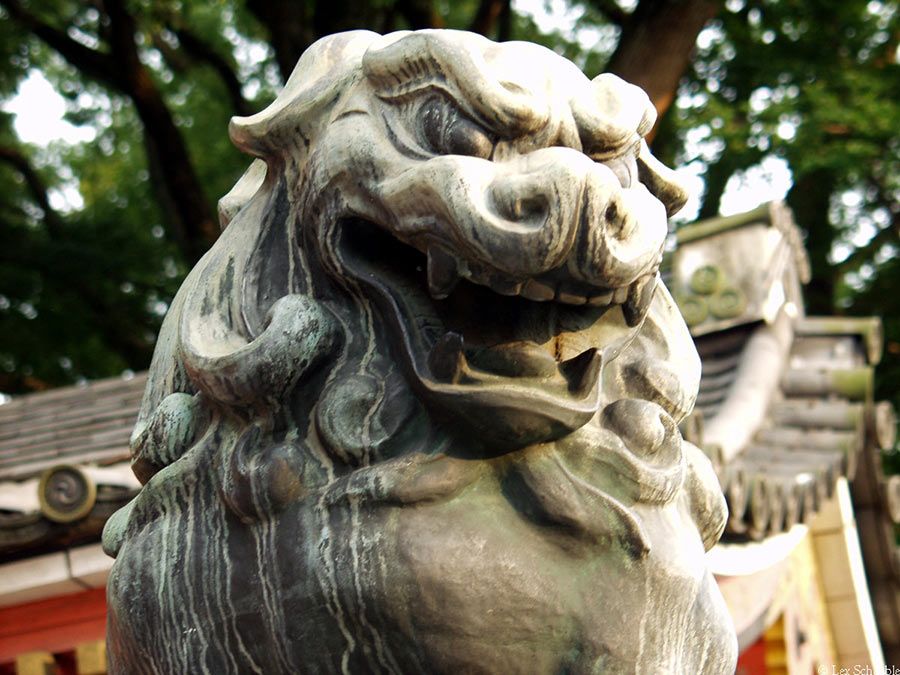
(Temple Guardian by Crys)
As Campbell puts it “…The threshold guardians are to ward away all incapable of the higher silence within.”
In mythology and folklore you will often find that the hero must pass a test or a trial in order to demonstrate that he is qualified to cross over into a new zone of experience. This usually requires that the hero is willing to make an offering to the threshold guardians: That s/he has a gift to give, or that s/he in some way is prepared to let go of something s/he holds dear. This is of course highly symbolic. What the crossing demands in psychological terms, is that we are willing to offer an aspect of ourselves in order to move forward.
What we need to offer to the “threshold guardians” is no other than the aspects of ourselves that prevent further development and awakening: Namely, all the regressive tendencies which pull us in the direction of safety and comfortable numbness. For as Campbell points out the “threshold guardians” are to be found at:
“… the limits of the hero’s present sphere, or life horizon. Beyond them is darkness, the unknown and danger; just as beyond the parental watch is danger to the infant and beyond the protection of his society danger to the member of the tribe”
This is where we need to take a leap and be willing to cut the umbilical cord that keeps us safely attached to our nest. Beyond the threshold guardians is unchartered territory, and the hero must show that he is prepared to lose sight of his homeland and venture into the unknown.
The threshold guardians are not malicious or evil creatures, but they actually perform a crucial function. They force us to approach the sacred with integrity and sincerity as they warn us: “What lies beyond, is not for everyone!”
Whether we enter the temple or not, is not the point. If we are not perceptive to the challenge posed to us, we will effectually have remained on the outside – and thus protected by the guardians. They are outer representations requiring an inner gesture of sacrifice. Only if we are prepared to take up this challenge, will we be able to cross into the yonder zone of new experience and magnified power.
In an often uncanny way, we become aware at the threshold that our “treasure hard to attain” comes with consequences. Once we cross, there is no turning back. The truths that we encounter in the dark can carry such significance and radiance that the experience will shake the center of our being. And once we have awoken the creatures of the abyss, we cannot just put them to sleep again. What has been seen cannot be unseen.
The Power of the Symbol
After the first encounter with the cave, I wasn’t exactly eager to “cross the threshold.” Sure, I was intrigued by the cave, and it maintained a strange sort of fascination in my being, but I was certainly not prepared to spend 5 days in darkness with the lizards. Rather, like the monk in the painting, I stood transfixed looking at the cave from a safe distance, not walking away, but not plunging in either.
So what made me take the plunge? I ask myself now. Was it pride and stupid stubbornness – a silly macho attitude eager to “conquer” the cave? Or a spiritual materialism, hungry for another trophy to place in the cabinet of “special experiences?” And if so, could I honestly say to myself that I was prepared to “cross the threshold?”
I suspect that I have many motives for my actions, and I doubt that I will ever be able to unravel the robe of mixed emotions and dubious drives that pull me. Some of them I deem to be noble and honest, others are more obscure to me – maybe even obscene. I’m convinced though, that beneath the pretensions of my rational mind, there is a vast ocean of unconscious drives exerting a much greater influence on me than what I would like to admit. As Freud was fond of saying: “We are not the masters of our own house.” And I can only agree.
However one chooses to perceive it, we have an unconscious with its own hidden meaning and dreamy language, or “arcana.” It speaks in symbols and the symbols can become alive in us. They move and they drive us – they frighten and they enlighten. And no matter how hard we try to dismiss them as “illusory,” the symbols mediate the way we play (la. illudere) with the material. They give shape to the way we embody the world.
When we breathe life into – or inspire (in–spiritus) – the symbols, they become “numinous” carriers of psychic energy – or “spirit” if you will – satiated with the vitality of life itself. As such they can carry a much stronger emotional charge than what our abstract concepts could ever hope to achieve. They will become psychic facts – real forces to be reckoned with.
In the rest of the essay I want to explain how I experienced this power of a symbol. With the help of Jung I will explore the possibility that it was a symbol – or rather; an “archetypal motif” – that was the real driving force behind my decision to enter the cave. I want to share the story of a dream and how it moved me.
An Apocalyptic Night
It begins one night, deep in the jungle of Guatemala. We were on a small expedition to share knowledge and plants with an indigenous village, spending some days far cut off from the “civilized” world. I was still not used to sleeping in my hammock, and it had begun to rain in the night. Not just the normal showers that we are used to in Europe, but a massive tropical downpour cascading down with raindrops heavy as lead.
The shower created a dramatic – almost apocalyptic – atmosphere in the night, as it plunged down on the thin tin roof of our wooden abode, sounding like one long and continuous roar from above. ‘This is it!’ I thought and smiled. ‘Now the shit is going to hit the fan!’
(The four horsemen of the Apocalypse: Conquest, war, famine and death. Painting by Viktor Vasnetsov, 1887)
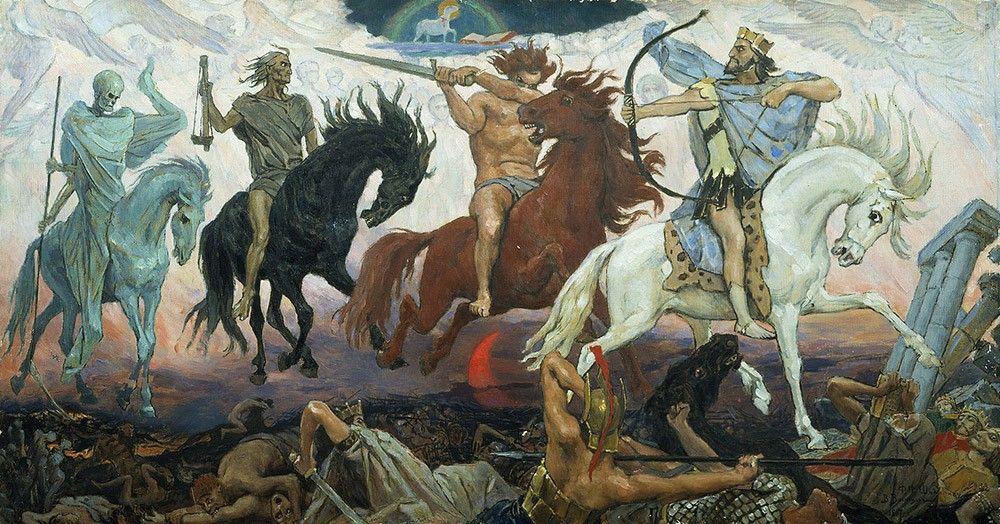
As I was lying there in my hammock – half awake, half dreamy – it felt as if something momentous was in the air, waiting to reveal itself. As I closed my eyes and gave in to the atmosphere, a dream of mine suddenly resurfaced.
Many months before embarking upon my journey I had a very vivid dream, where I saw myself lying dead on the floor. Vividly realizing that I had died, a surge of great remorse and nostalgia flowed forth in my being. Yet it was not all sad and gloomy. Even though there was grief connected to the image, joy was hiding behind it. My death was actually something to be honored and celebrated. At the end of the dream my dead corpse was replaced with a baby, surrounded by three women. I had no idea what the three women were doing there, but it was clear to me that new life had been born – and it carried a soft radiance with it.
As I was laying there in my hammock in the middle of the night recalling my dream, it suddenly dawned on me. My trip is not about cacao. It’s actually not about learning this, doing that, or going there. My trip is simply about dying!
Moved by an Archetype
As I’m writing this a part of me feels that it’s ludicrous – so far removed from my ordinary sense of self: ’Nikolaj!’ I tell myself, ‘… You old fantasist!’ This is too much, and you have gone too far now. First you identify yourself with “a hero,” and now you are about to claim that you have gone through “a death and a rebirth.” ‘Jesus! Who do you think you are?’
When I speak the language of the purely rational, I must admit that this “heroic narrative” looks quite absurd – even suspicious. But to my great fortune – and sometimes catastrophic misfortune – I’m not just a rational being. I too am an irrational creature, immersed in a rich undergrowth of hidden drives and obscure symbols. And seen from this subterranean point of view my story looks quite different. I then begin to wonder whether there was a mysterious – yet effective – connection between my dream and my decision to enter the cave; whether my days in darkness were driven by an ancient archetypal motif of “death and rebirth.”
Jung often stressed the point, that our psyche is not a clean slate (“tabula rasa”) when we enter the world. For the psyche, according to Jung, is not just personal, but also cultural and historical – “transpersonal” if you will. Through the world of the unconscious we inherit a vast pool of collective imagery. As he writes in Man and His Symbols:
“Just as the human body represents a whole museum of organs, each with a long evolutionary history behind it, so we should expect to find that the mind is organized in a similar way. It can no more be a product without history than is the body in which it exists. This immensely old psyche forms the basis of our mind, just as much as the structure of our body is based on the general anatomical pattern of the mammal. The trained eye of the anatomist or the biologist finds many traces of this original pattern in our bodies. The experienced investigator of the mind can similarly see the analogies between the dream pictures of modern man and the products of the primitive mind, its “collective images,” and its mythological motifs.”
Although they appear differently in each individual, the underlying pattern of the “collective images” – or “archetypes” – is a culturally shared heritage. That is why they can so easily grip, not just an individual, but also a culture at large. And when they do, they not only give rise to personal bias and complexes, but to whole mythologies, religions and philosophies. As such, they can shape the character of entire nations and epochs of history. The archetypes become a mental therapy for the sufferings and anxieties of a culture at large; socially ingrained ways of coping with the hardships of life.
The myth of the hero – often involving the act of a death and rebirth – is certainly no exception. For millennia it has given rise to hope and fears, joys and sorrows; in different shapes and colors it has moved and touched our hearts across vast stretches of time and space. And even though we today might discard it as an old “pre-rational” myth used to console or compensate, I don’t find it hard to believe that the image of the hero is still alive and kicking in the depths of our unconscious.
The Ancient Motif of Death and Rebirth
We might not believe in myths any more, but their symbolic forms – the so called “archetypes,” or “primordial images” as Jung also calls them – can still exert a vital function in our lives. They can emerge from our unconscious at times when we need to make a change and influence us in profound ways. In these times it is as if our psyche will enforce an image upon us, that we need to deal with in order to grow.
The theme of death and rebirth seems at least to be intimately related to the phases in our lives when we are challenged to make a transition; when we need to leave behind an old form in order to enter into a new sphere of existence. In these moments we have to let go of – or offer – an aspect of ourselves. Just like the snake sheds its old skin, we need to die in order to assume a new form. This is an act that been a most essential part of most native cultures for aeons.
At the center of the “rite of passage,” for example, lies the motif of death and rebirth: The initiation into a new group of the tribe/culture, requires a death of the old form. This transmutation of one form into another, is what the ritualistic act, as such, conceives. Whether in a brief moment of trance through dance, song or drum, a painful physical exhaustion, or a long excursion into the realms of Spirit, the ritual provides us with the cultural container in which we can experience a symbolic death and rebirth. The ritual is “an offering” of ourselves.
Read this: Ayahuasca: A Story of Death, Rebirth and Love
In this dark light, my experience is neither unique nor special, and need not carry any messianic connotations with it. For neither Jesus nor Christianity can claim any exclusivity on the motif of death and resurrection. Its roots run much deeper in the Western cultural heritage; they stretch through Greek mythology and its Mystery Cults (Dionysian, Orphic, Eleusinian), all the way into ancient Egypt and the myth of Osiris. And in the broadest sense of the word it is a “cross–cultural” motif: Ganesha to the East, Odin in the North, Quetzalcoatl in the West: all these culturally independent gods shared a similar fate of death and rebirth.
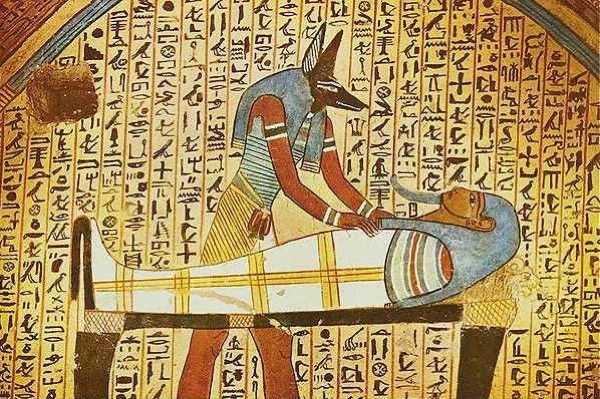
(Osiris, amongst others, was murdered and cast into the Nile, but by the help of his wife, Isis, brought back to life)
If we give credit to Jung’s observations of a “collective unconscious,” then it should come as no surprise that this motif is part of our shared and very common psychic make–up; a symbol deeply imprinted in the depths of our psyche.
Whether my dream was the manifestation of such an “archetypal” motif is still obscure to me. All I can say is that my dream had a strong and tangible effect on me. After that rainy night in the jungle, when it reappeared so forcefully, a change occurred in the way I related to the cave. It began to hold sway over me as it now appeared to be the ideal opportunity to fulfill what I began to see as the real purpose of my journey – “a dying.”
Crossing the Threshold
Somewhere “deep down” a part of me knew that my journey was about allowing for a transition to take place. It had been a year since I finished my studies, and that had marked quite a significant change in my outer reality. I could no longer lean against the socially sanctioned role of “the student.”
On the inside though, I was still clinging to an old and familiar form. I might have gone from student to teacher and from pupil to scholar, but looking back now I can see that I was still governed by the same dispositions, same patterns, and same inhibitions. A shift was needed in order to break free from the comfy student chamber – or monk’s cell – that I had been decorating for so long. I had to let go of the introvert scholar who observes life from a distance – who reads books about it – but never dares to fully participate in it.
Surely, my rational mind was not the place from where I could perform this task. Rather, it was the main obstacle preventing the shift from occurring. I needed to dig deeper if I wanted to make the transition into a new way of being in the world. Like the monk in the painting, I had to plunge myself into the sea of the unconscious, and let my scholarly – and to some extent monastic – sense of self dissolve. I had to cross the threshold.
In myths, fairytales, and folklore we often come across the threshold as a dark forest, a raging river, or a deep valley that the hero must cross in order to progress on the journey. But from a psychological perspective the threshold so often depicted as a physical point of crossing, is none other than the boundary within the psyche itself: It is the demarcation between our clear waking consciousness and the vast sea of the unconscious.
Once we cross the threshold we enter the shadowy kingdom of the unconscious, so often depicted in mythology as “the underworld.” In order to restore life, the hero has to descend into the realm of the dead: A classic among the classics in mythology, one of the most famous being Psyche’s quest to save Cupid from his sleep in Hades, the underworld of Greek mythology.
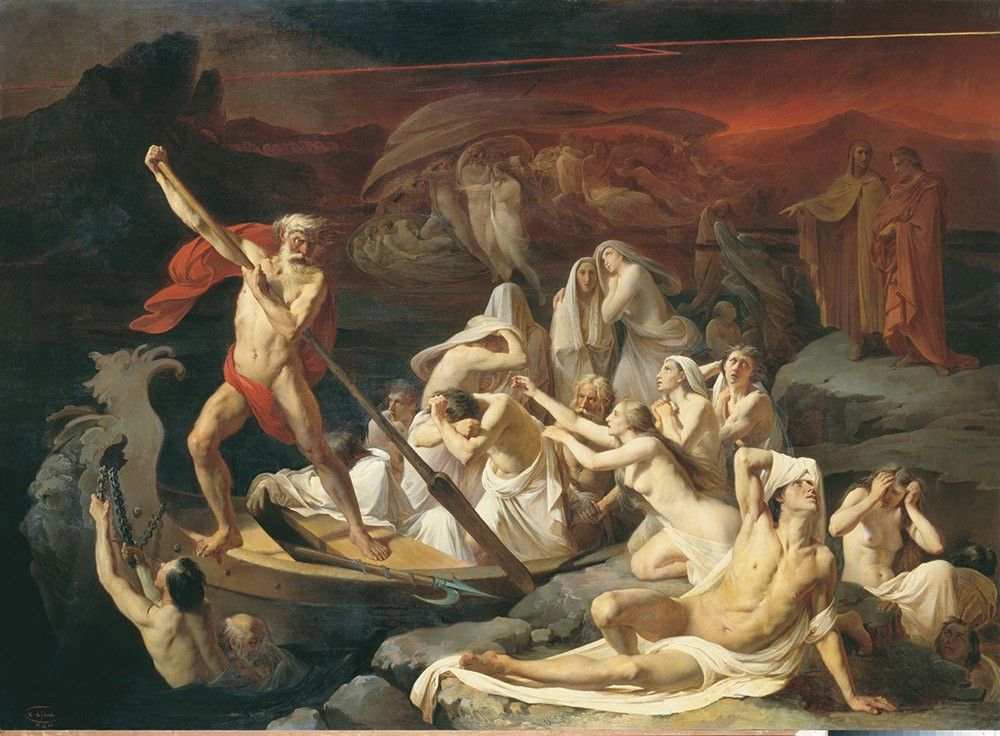
(Psyche being taken across the river of Styx by Charon, the ferryman. A 19th-century interpretation of Charon’s crossing by Alexander Litovchenko.)
It is this very descent into the unconscious – or “the underworld” – that Jung called “the perilous adventure of the night sea journey.”
The Night Sea Journey
What makes the descent so perilous is the fact that we – to some extent – let ourselves disintegrate by the powers of the Unconscious. In its dark sea our stable sense of self begins to float and move; it begins to lose its outlines as the boundaries between self and other, inside and outside, become malleable.
This need not be problematic. On the contrary, it can be a deeply enriching experience as we get to incorporate hitherto excluded aspects of ourselves. But if we lose the boundaries of the self altogether, we risk becoming flooded by unconscious material. And then we face a serious psychological problem – probably diagnosed as a “psychosis” or “schizophrenia” – as we cannot maintain a coherent sense of self. We need strength, stamina, and stability, not only to descend and dissolve, but also to re-emerge and reintegrate.
Besides getting intimate with the lizards – or “the threshold guardians” – this “descent” was what intimidated me most about the cave. I regard myself as a sensitive person, and I know that the psyche is a delicate thing – not to be played around with frivolously. Just by being in a rather secluded spot in the jungle, I felt that the alchemical vessel of my psyche was already hot and cooking. So I was nervous whether I could handle the extra heat. Was I pushing it too far? Was “the cave” just a hazardous and egoic attempt to fill in a symbolic gap? Or was it a deeper and more constructive drive to awaken and grow?
Only in the Dark
It is indeed a fine line between having the necessary motivation and courage on our journey, and then becoming overly pushy. If we are too careless we might risk burning out – or worse, severely damaging ourselves. On the other hand: Transformation is necessarily a game where our very being is at play – and we will never grow if we don’t take any risks. For what lies buried beneath our fear and anxiety is our actual material for growth and transfiguration.
Perhaps it is all our crazy hopes and fantasies, our mad creativity and spontaneity? Perhaps it is our wild sensuality and lust, or maybe our fierce rage and anger? No matter what we have been hiding in the dark, it is part of “the treasure” that the hero is committed to retrieve in the underworld. For it is only in the dark that we will be able to discover – and eventually recover – what we have been denying ourselves. As Joseph Campbell assures us:
The purpose of the descent as universally exemplified in the myth of the hero is to show that only in the region of danger (watery abyss, cavern, forest, island, castle, etc.) can one find the “treasure hard to attain”.
From this perspective I could hardly have imagined a more ideal setting than a cave full of lizards. It had all the symbolic ingredients that I could have wished for: danger, darkness and descent, lizards, and animality – at one and the same time tomb and womb.
Most importantly though: It provided the space in which I could explore what I had been hiding from myself. Just like the painter needs a canvas in order to paint the images of his soul, so I needed a dark cave for the projections of my unconscious. As for the Maya, the cave became a portal to the underworld (xibalba): a tunnel leading down into the world of my unconscious.
It appeared as a necessary step, that I had to take, in order to individuate.
The Force of Individuation
Imaginably, it was somewhat of a drastic and dramatic way to do it, but sooner or later I would have been forced to deal with the contents of the Unconscious. For some, it will manifest itself in sudden outbursts of uncontrollable emotions. In my case, it was in depressive moods, lack of drive, and an overly introverted approach to life. Whether it explodes or implodes, our shadow harbors an energy, that will eventually become destructive if it is not integrated.
These are the simple, but wise, workings of the Unconscious: With a logic of its own it will keep seeking a higher degree of integration by continuously confronting us with what we don’t want to concede. The unconscious will push us into situations, where we are forced to look at it.
As such, there seems to be a natural pull toward integration and growth in the psyche. It is not only regressive, as Freud believed – always pointing backward to infantile emotions and the need for the nipple – but, according to Jung, it contains a wisdom, which points forward toward a greater vision of wholeness. Just like the acorn contains the seed to become a tree, so does our psyche contain a natural potential. And if we learn how to give form to this potential buried in our dark soil, we can grow to experience its full blossoming and actuality.
It is this process of discovery and growth which Jung called “individuation”. It is the movement by which we “become who we are” — not just scattered and helpless products of our time and mass culture, but unique and “in–divided” – individuals with our own sense of purpose and power to pursue it. This, Jung believed, is the overarching purpose of the dream matrix per se: to guide us on our journey toward individuation and wholeness.
From this perspective “the myth of the hero” is none other than the symbolic representation of the individuation process. It depicts a journey that we all go through as we unfold ourselves as individuals. It is a treasure map deeply inscribed in the collective unconscious — age-old and universal in its structure, but fresh and singular in every individual who gives birth and bones to it anew.
Whether it is through creative writing, painting, art, meditation, spending time in nature, recalling our dreams, active imagination, or some other “technique of the self”, we can learn how to deepen the relationship with our unconscious. When we nourish it – when we attend to its symbols and listen to its dreamy voice – then the treasure map of the hero can become alive in us. It can begin to speak to us, and feed us with symbolic gestures, bolstered with archetypal significance. It will guide and lead us by pointing the way forward in the dark.
A Letter Inscribed in the Heart
Coming to a dark end of this essay, I am reminded of an old gnostic text called “The Hymn of the Pearl”. In this ancient religious script we read about a “son of a king” who is sent to the dark land of Egypt in order to retrieve a pearl. Pacified by “the heavy food of the Egyptians” he becomes a “son of the house” and forgets about his mission and journey:
“I fell into a deep sleep.
I forgot that I was a son of kings,
And served their king.
I forgot the pearl,
For which my parents had sent me”
Nonetheless he carries a letter from his homeland. It is “inscribed in his heart,” and it reminds him of his quest for the pearl. What a beautiful symbol the pearl is – a precious little thing hiding on the bottom of the dark ocean.
If I go with the story of affirmation, I was reading a letter “inscribed in my heart” when I decided to enter the cave. It was conveyed in a dream, written in the language of the symbol, and it told the ancient tale of “death and rebirth”. The pieces of the puzzle were coming together, and a highly symbolical – yet powerful – map was emerging. I could now see where my treasure was to be attained.
My hero’s journey was becoming alive as an animating force, breathing and moving inside of me. Slowly, I was beginning to speak the arcane language of the symbol – and to my amazement, the world was speaking back to me. A river became a place where I could converse with nymphs – and not just a place to take a swim; the Ceiba trees in the rainforest became the life principle of man – and not just pieces of lumber; and a cave became a portal to the underworld – and not just an empty hole in a hill.
The symbolic and the real were coming together in a deep and intimate reciprocity, as two sides of one and the same flesh. Accompanied by a childlike joy and enthusiasm the world was once again revealing itself as a wondrous playground for the projections of my imagination; a site of “mystical participation.”
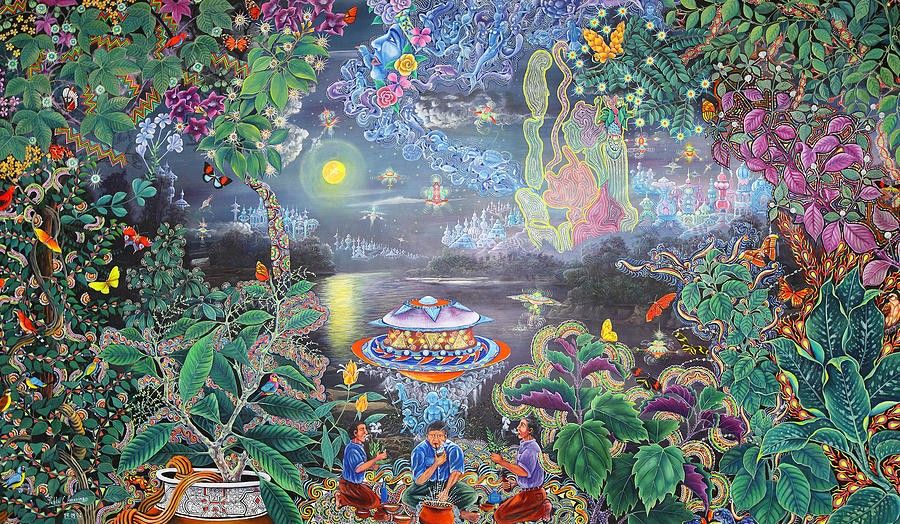
(Misterio Profundo by Pablo Amaringo)
My studies have given me much and I’m truly grateful that I had the opportunity to explore the majestic realm of the intellect. But practiced in excess, I had become robbed of this profound contact with the natural world – and the powerful emotional energy that is contained in this symbolic connection. Living in the city, studying, and spending large amounts of time in front of the screen, I had come to disclose my world from an ever more rational and technological perspective.
No doubt about it: Alienation is an evolutionary step that has bestowed many civilized gifts on us, but when we lose contact with our roots altogether – with our natural environment and our own bodily instincts – then we suffer a tremendous loss: the sense of a deeper purpose and direction in life, the feeling of profound joy and explosive vitality, of deep belonging and endless appreciation. These are qualities which we will never be able to “order” from above, but sentiments which can only well up from below; from our bodies and our rich emotional life. We then begin to uncover a more poetic way of opening the world — one in which life seems to overflow with meaning and significance, with mystery and radiance.
This, I believe, was what the cave offered me: a way for me to subvert the nihilism inherent when the rational reigns supreme. The king had become sick, locked inside his empty castle of concepts, unable to move from from his ceaseless considerations. And only by a night sea journey, across the boundaries of this barren land, could a remedy be at hand.
More literally than one would expect, the threshold marked a boundary between two different worlds for me: my comfy, but exhausted, academic homeland of pure intellectualism, and a new, yet unknown, realm of increased enchantment and sensuality.
Already by venturing out on my journey I could smell this yonder zone of experience. And its scent increased as I approached the moldy cave. My body and my head were once again communing; psyche was conversing with physis, and the “inner “ and “outer” were beginning to have a dance in the mirror of reality. And out of this fantastic mirage a pearl was becoming visible. Now the time was ripe to take a dive.
Approaching Darkness
Unintendedly, and as if the symbolical load was not already heavy enough, it happened to be Maundy Thursday that I was to enter the cave – exiting again Easter Monday. After “a last supper”, Elisa and I made our way up to the the cave. And as the lover of cacao that I am, I had brought a small brew of the sacred substance. I was careful not to approach the “threshold guardians” empty handed. Once we got seated in the cave, we offered the cacao and set our intentions for the immersion.
Dusk was approaching while we sang our chants and drank the cacao, and I knew that it wouldn’t be long until Elisa had to make her way back to Alquimia. With the last beams of light entering the cave, my shadow was projected onto the back wall of the cave. ‘How symbolical!’ I thought, as I waved to greet it. Elisa then closed up the cave, and the space around me became pitch black.
My descent had begun.
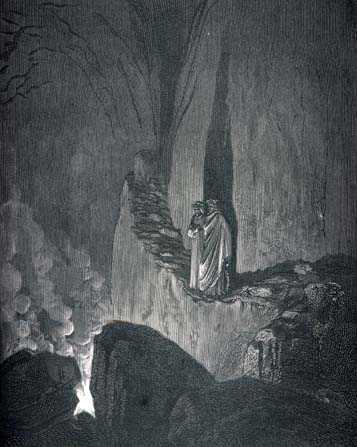
(Gustave Dore, Inferno)
Litterature:
Campbell, Joseph: The Hero with a Thousand Faces, Princeton University Press, 1949
Jung, Carl Gustav: Psychology and Alchemy, Routledge, 1953
Jung, Carl Gustav, Ed: Man and His Symbols, Anchor Press, 1964

